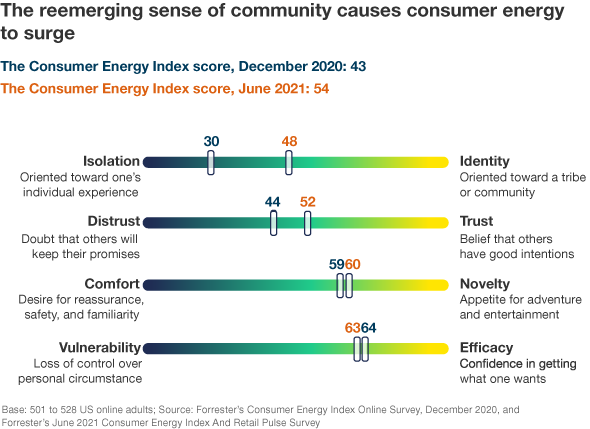Emotionally Charged Consumers Are Ready For New Experiences
Since the onset of the COVID-19 pandemic in the US in March 2020, we’ve been tracking precisely how the pandemic and related crises have taken an emotional toll on consumers by applying Forrester’s Consumer Energy Index, our data-driven framework that captures how ready and willing consumers are to reach out to brands.
The disruption in the first half of 2020 plunged consumers into a state of isolation, distrust, and vulnerability. Watching businesses reopen in fits and starts and experiencing episodes of activism rekindled sparks of consumer energy through the middle of the year. Consumer energy dropped to a record-setting low by the end of September, until the contentious US presidential election, initial vaccine rollout, and promise of a new year drove consumer energy to rise.
Now, as the CDC officially lifts COVID-19 restrictions and the largest vaccine campaign in history forges ahead, consumers are beginning to reunite with loved ones and return to their favorite experiences. Our latest pulse of data reveals that overall consumer energy has rebounded from 43 in December 2020 to 54 as of June 2021 and is heavily driven by consumers’ intensifying sense of community:

What The Data Means
At this moment:
- Consumers are feeling a much stronger community connection after months of deep isolation. Consumer energy “identity” scores have been falling ever since the onset of the pandemic in early March 2020 as physical distancing drove emotional isolation. Now that consumers are gathering with friends and family, spending time in brick-and-mortar stores with fellow shoppers, and returning to work side-by-side with colleagues, they’re experiencing a more robust sense of affiliation with their communities and a deeper affirmation of who they are and what they stand for.
- Consumers are more willing to trust leaders and organizations. While consumer trust levels remained low for much of 2020 because of a steady skepticism about brands’ intentions, the latest 8-point increase along the “trust” dimension means that consumers are more open to the idea that people and organizations around them are driven by good intentions and are equipped to follow through on their promises.
- Consumers are eager and optimistic about novelties. Throughout the pandemic, consumers have been experiencing an emotional tug-of-war between seeking familiarity and variety. A score of 60 along the “novelty” dimension indicates that consumers are excited about the prospect of learning something new, taking an adventure, or being entertained.
- Consumers are flexing their empowerment and ability to recover control. Consumers’ sense of control took the biggest hit when the pandemic initially reached the US 16 months ago. Now, consistently high “efficacy” scores indicate that consumers are compelled to reach for new tools, resources, and solutions to improve their quality of life.
What It Means For Brands: Match Consumers’ Emotional Tone To Show You Are On Their Side
- Factor the ebb and flow of consumer emotion into your messaging, product, and experience. Consumer emotions are the key to catalyzing economic and social recovery. The high levels of consumer energy in this moment reveal that consumers are enthusiastic and open to new brands, products, and experiences. However, the lurking threat of coronavirus variants, hesitation around vaccine compliance, and residual fear or trauma from the crises of 2020 mean that the consumer psyche is still fragile. CMOs that connect with consumers in an emotionally intelligent, empathetic way can allay lingering consumer fears and encourage excitement and optimism for the road ahead.
- Empower consumers to tighten their community bonds. Over a third of US online adults say they are spending more time thinking about how they can play a role in their local community, and many consumers are projecting this motivation onto their brand choices. As consumers compensate for months of isolation by finding their community groups, allow your brand to be the great connector that brings like-minded consumers together.
- Validate consumers’ growing trust in companies by proving your brand promise more urgently than before. As we’ve written in recent research, the confluence of social, cultural, and economic disruptions is creating a path for businesses to step forward as some of the most trusted entities. Consumers, employees, and partners are desperate for businesses to promise safe and secure relationships; consumer energy shows that customers are giving brands permission to play a bigger role in their well-being. Now is the time for companies to embrace trust as a strategic imperative before competitive players lock in consumer trust capital first.
Questions, comments, or ideas? I look forward to sharing more data detail and discussing via inquiry.
